Admiral ATW4475YQ, ITW4400YQ, ITW4500YQ, NTW4400YQ, NTW4500YQ Owner's Manual
...
TOP-LOADING |
LAVEUSE À CHARGEMENT |
WASHER |
PAR LE DESSUS |
USE AND CARE GUIDE |
GUIDE D’UTILISATION |
|
ET D’ENTRETIEN |
Table of Contents |
Table des matières |
WASHER SAFETY.......................................................... |
2 |
WHAT’S NEW UNDER THE LID?.................................. |
3 |
CONTROL PANEL AND FEATURES............................. |
4 |
CYCLE GUIDE................................................................ |
5 |
USING YOUR WASHER................................................. |
6 |
WASHER MAINTENANCE............................................. |
9 |
TROUBLESHOOTING.................................................. |
10 |
WARRANTY................................................................. |
14 |
ASSISTANCE OR SERVICE......................... |
Back Cover |
SÉCURITÉ DE LA LAVEUSE....................................... |
|
15 |
QUOI DE NEUF SOUS LE COUVERCLE?.................. |
16 |
|
TABLEAU DE COMMANDE ET |
|
|
CARACTÉRISTIQUES................................................. |
|
17 |
GUIDE DE PROGRAMMES......................................... |
|
18 |
UTILISATION DE LA LAVEUSE................................... |
|
19 |
ENTRETIEN DE LA LAVEUSE..................................... |
|
22 |
DÉPANNAGE................................................................ |
|
24 |
GARANTIE.................................................................... |
|
29 |
ASSISTANCE OU SERVICE............ |
Couverture arrière |
|
Para una versión de estas instrucciones en español, visite www.amana.com
W10420400A W10420401A - SP
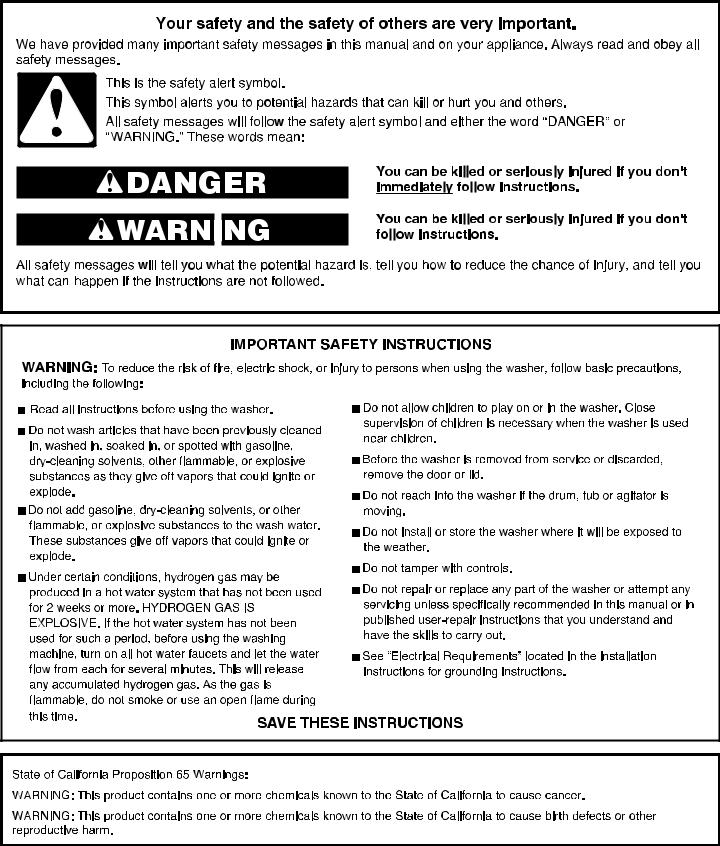
WASHER SAFETY
2

WHAT’S NEW UNDER THE LID?
Your new washer will operate differently than your past agitator-style washer.
Lid Lock
To allow for higher spin speeds, the lid will lock and the Lid Locked light will turn on. When this light is lit, the lid is locked and cannot be opened. When this light is blinking, the washer is paused. When this light is off, the lid can be opened. After a cycle is started, the lid locks, unlocks, and locks again. If you need to open the lid to add a garment after this point, you must press START/PAUSE/UNLOCK
and wait for the lid to unlock. The lid will only unlock after washer movement has stopped. Depending on when in the cycle you try to pause, it may take several seconds to several minutes for the lid to unlock.
Sounds
At different stages of the wash cycle, you may hear sounds and pauses that are different from those of your previous washer. For example, you may hear a clicking and hum at the beginning of the cycle as the lid lock goes through a self-test. There will be different kinds of humming and whirring sounds as the agitator tests for load balance or moves the load. And, sometimes, you may hear nothing at all as the washer allows time for clothes to soak.
Sensing
This washer will perform a series of spins to check for load balance. When a load is started, it may take 2–3 minutes before water begins to enter the basket. During this time, a series of clicks and a whirring noise signal that sensing technology is determining if there is an off-balance load.
IMPORTANT:
Spray Rinse
Select cycles default to a spray rinse. During these cycles, you will hear water enter the washer as the tub spins, allowing the rinse water to penetrate clothes. Check the “Cycle Guide” for details.
•Washer will not operate if the lid is open.
•Washer will not begin to fill with water until the lid is closed, locked, and the sensing process is complete. This delay in fill could take 2–3 minutes.
•Fabric Softener option must be selected to ensure fabric softener dispenses at the correct time.
3
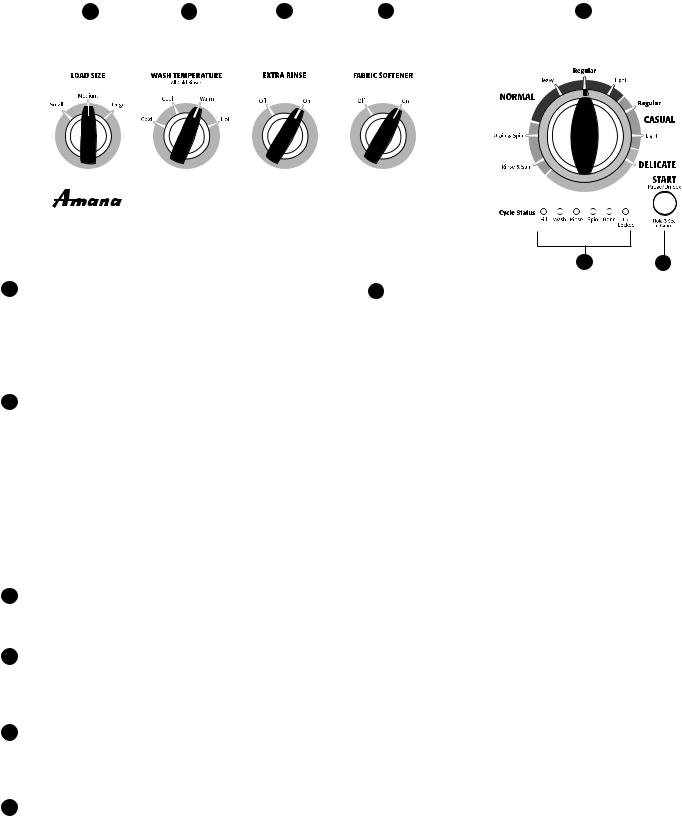
CONTROL PANEL AND FEATURES
1 |
|
2 |
3 |
4 |
|
5 |
|
||||||||
|
|
|
|
|
|
|
|
|
|
|
|
|
|
|
|
|
|
|
|
|
|
|
|
|
|
|
|
|
|
|
|
|
|
|
|
|
|
|
|
|
|
|
|
|
|
|
|
|
|
|
|
|
|
|
|
|
|
|
|
|
|
|
|
|
|
|
|
|
|
|
|
|
|
|
|
|
|
|
|
|
|
|
|
|
|
|
|
|
|
|
|
|
|
|
|
|
|
|
|
|
|
|
|
|
|
|
|
|
|
|
|
|
|
|
|
|
|
|
|
|
|
|
|
|
|
|
|
|
|
|
|
|
|
|
|
|
|
|
|
|
|
|
|
Not all features and options are available on all models. Appearance may vary.
1LOAD SIZE
Select the setting most suitable for your load. Small will add a low amount of water for smaller loads and
Large will add the most amount of water for large or bulky loads. Items need to move freely. Tightly packing can lead to poor cleaning performance, and may increase wrinkling and tangling.
2WASH TEMPERATURE
Temperature Control senses and maintains uniform water temperatures by regulating incoming hot and cold water.
Select a wash temperature based on the type of fabric and soils being washed. For best results and following the garment label instructions, use the warmest wash water safe for your fabric.
•Warm and hot water will be cooler than what your previous washer provided.
•Even in a cold and cool water wash, some warm water may be added to the washer to maintain a minimum temperature.
3EXTRA RINSE
This option can be used to automatically add a second rinse to most cycles and must be set to ON if adding a second rinse to a cycle.
4FABRIC SOFTENER
This option can be added to most cycles and must be set to ON if using fabric softener during a cycle. It ensures that fabric softener is added at the correct time in the rinse for even distribution.
5WASH CYCLE KNOB
Use the Wash Cycle knob to select available cycles on your washer. Turn the knob to select a cycle for your laundry load. See “Cycle Guide” for detailed descriptions of cycles.
6START/PAUSE/UNLOCK BUTTON
Press to start the selected cycle; press again to pause the cycle and unlock the lid.
NOTE: If the washer is spinning, it may take several minutes to unlock the lid. Press and hold for 3 seconds to cancel a cycle.
7 6
7CYCLE STATUS LIGHTS
The Cycle Status Lights show the progress of a cycle. At each stage of the process, you may notice sounds or pauses that are different from traditional washers.
FILL
When the Start/Pause/Unlock button is pressed, the washer will first perform a self-test on the lid lock mechanism. You will hear a click, and the lid will unlock briefly before locking again. The washer will use spins to check for load balance. These spins may take several minutes before water is added to the washer. You may hear the hum of the spins before filling. This is normal.
WASH
You will hear the agitator moving the load. The motor sounds may change at different stages in the cycle. The wash time is determined by the selected soil level.
RINSE
You will hear sounds similar to the wash cycle as the washer rinses and moves the load. You may hear the motor turning on briefly (short hum) to move the basket while filling. Fabric softener will be added if the Fabric
Softener knob was set to ON.
Some cycles use spray rinsing. After draining and spinning out wash water, the washer will continue to spin and spray in rinse water for the entire rinse time.
SPIN
The washer spins the load at increasing speeds for proper water removal, based on the selected cycle and spin speed.
DONE
Once the cycle is complete, this light will come on. Remove the load promptly for best results.
LID LOCKED
To allow for higher spin speeds, the lid will lock and the Lid Locked light will turn on. When this light is on, the lid is locked and cannot be opened. When this light is blinking, the washer is paused. When this light is off, the lid can be opened.
If you need to open the lid, press START/PAUSE/ UNLOCK. The lid will unlock once the washer movement has stopped. This may take several minutes if the load was spinning at high speed. Press START/PAUSE/ UNLOCK again to resume the cycle.
4

CYCLE GUIDE
For best fabric care, choose the cycle that best fits the load being washed.
Not all cycles and options are available on all models.
Items to wash: |
Cycle: |
Wash |
Spin |
Cycle Details: |
|
|
Temperature*: |
Speed: |
|
|
|
|
|
|
Large items such |
Normal |
Hot |
High |
Use this cycle for heavily soiled cottons and mixed fabric |
as sheets, small |
Heavy |
Warm |
|
loads. This cycle features a spray rinse. |
comforters, jackets |
|
Cool |
|
|
|
|
Cold |
|
|
|
|
|
|
|
Cottons, linens, |
Normal |
Hot |
High |
Use this cycle for normally soiled cottons and mixed fabric |
sheets, and mixed |
Regular |
Warm |
|
loads. This cycle features a spray rinse. |
garment loads |
|
Cool |
|
|
|
|
Cold |
|
|
|
|
|
|
|
Lightweight cotton |
Normal |
Hot |
High |
Use this cycle for lightly soiled cottons and mixed fabric |
fabrics |
Light |
Warm |
|
loads. This cycle features a spray rinse. |
|
|
Cool |
|
|
|
|
Cold |
|
|
|
|
|
|
|
No-iron fabrics, |
Casual |
Hot |
Low |
Use this cycle to wash loads of no-iron fabrics such as |
cottons, perm |
Regular |
Warm |
|
sport shirts, blouses, casual business clothes, permanent |
press, linens, |
|
Cool |
|
press, and blends. |
synthetics |
|
Cold |
|
|
|
|
|
|
|
Lightly soiled |
Casual |
Hot |
Low |
Use this cycle to wash lightly soiled loads of no-iron |
no-iron fabrics, |
Light |
Warm |
|
fabrics such as sport shirts, blouses, casual business |
cottons, perm |
|
Cool |
|
clothes, permanent press, and blends. |
press, linens, |
|
Cold |
|
|
synthetics |
|
|
|
|
|
|
|
|
|
Machine-wash |
Delicate |
Hot |
Low |
Use this cycle to wash lightly soiled garments indicating |
silks, lingerie, |
|
Warm |
|
“Machine Washable Silks” or “Gentle” cycle on the care |
washable wools |
|
Cool |
|
label. Place small items in mesh garment bags before |
|
|
Cold |
|
washing. This cycle features a spray rinse. |
|
|
|
|
|
Swimsuits and |
Rinse & |
Cold rinse only |
High |
Combines a rinse and high speed spin for loads requiring |
items requiring |
Spin |
|
|
an additional rinse cycle or to complete a load after power |
rinsing without |
|
|
|
interruption. Also use for loads that require rinsing only. |
detergent |
|
|
|
|
|
|
|
|
|
Dripping wet or |
Drain & |
N/A |
High |
This cycle uses a spin to shorten drying times for heavy |
hand-washed |
Spin |
|
|
fabrics or special-care items washed by hand. Use this |
items |
|
|
|
cycle to drain washer after cancelling a cycle or completing |
|
|
|
|
a cycle after a power failure. |
|
|
|
|
|
NOTE: Be sure to set Fabric Softener knob to ON, if adding fabric softener to load.
*All rinses are cold.
5

USING YOUR WASHER
1. Sort and prepare your laundry
2. Add detergent
•Empty pockets. Loose change, buttons, or any small object can pass under the agitator and become trapped, causing unexpected sounds.
•Sort items by recommended cycle, water temperature, and colorfastness.
•Separate heavily soiled items from lightly soiled.
•Separate delicate items from sturdy fabrics.
•Do not dry garments if stains remain after washing, because heat can set stains into fabric.
•Treat stains promptly.
•Close zippers, fasten hooks, tie strings and sashes, and remove non-washable trim and ornaments.
•Mend rips and tears to avoid further damage to items during washing.
Helpful Tips:
•When washing water-proof or water-resistant items, load evenly.
•Use mesh garment bags to help avoid tangling when washing delicate or small items.
•Turn knits inside out to avoid pilling. Separate lint-takers from lint-givers. Synthetics, knits, and corduroy fabrics will pick up lint from towels, rugs, and chenille fabrics.
NOTE: Always read and follow fabric care label instructions to avoid damage to your garments.
Add a measured amount of detergent into the bottom of the washer basket before adding clothes. If using an Oxi or color-safe bleach laundry boost product, add to the bottom of the washer basket, as well.
IMPORTANT: Follow the manufacturer’s instructions to determine the amount of detergent to use.
6
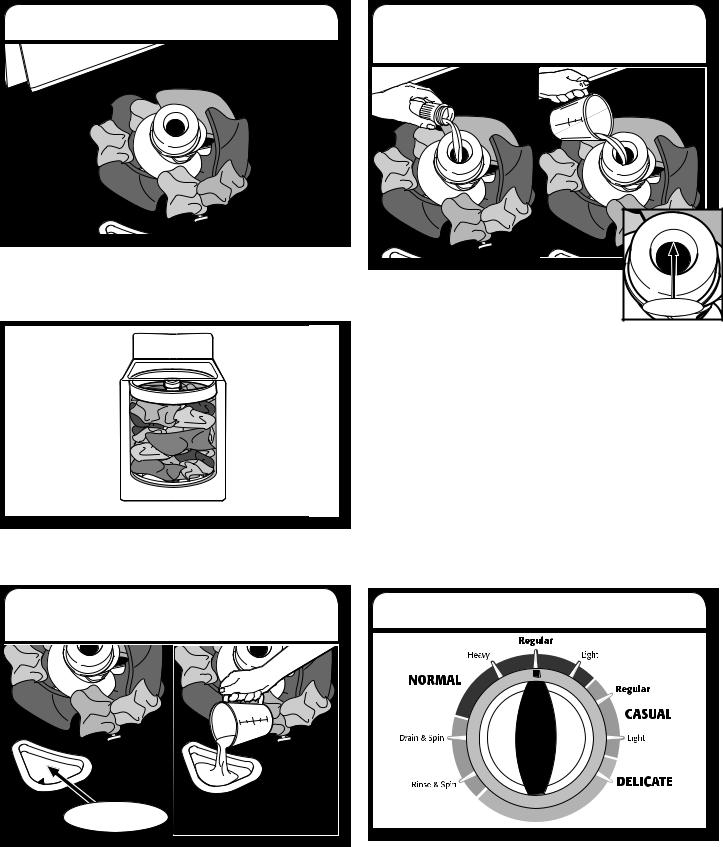
3. Load laundry into washer |
5. Add fabric softener to dispenser |
|
(on some models) |
Load garments in loose heaps evenly around basket wall. For best results, do not pack the load tightly. Do not wrap large items such as sheets around the agitator; load them in loose piles around the sides of the basket. Try mixing different sized items to reduce tangling.
IMPORTANT: Do not tightly pack or force items into washer. Items need to move freely for best cleaning and to reduce wrinkling and tangling.
4. Add liquid chlorine bleach to dispenser
Liquid
Chlorine Bleach
Do not overfill, dilute, or use more than 1 cup (250 mL). Do not use color-safe bleach or Oxi products in the same cycle with liquid chlorine bleach.
Pour a measured amount of liquid fabric |
|
softener into dispenser; always follow |
|
manufacturer’s directions for correct amount |
MAX FILL |
of fabric softener based on your load size. |
|
Dilute liquid fabric softener by filling the dispenser with warm water until liquid reaches the underside of the rim. See Max Fill line arrows. Then set Fabric Softener option knob to ON.
IMPORTANT: Fabric Softener option knob must be set to ON to ensure proper distribution at correct time in cycle.
Adding Liquid Fabric Softener Manually to Wash Load
During the final rinse, wait until the washer has completed filling, press the START/PAUSE/UNLOCK button to pause the washer. Lift the lid and add the measured recommended amount of liquid fabric softener. Do not allow liquid fabric softener to spill, splash,
drip, or run into the basket or on load. Do not use more than the recommended amount. Close the lid and press the START/ PAUSE/UNLOCK button again to start the washer.
IMPORTANT: Fabric Softener option knob must be set to ON to ensure proper distribution of the fabric softener during the rinse portion of the cycle.
6. |
Select CYCLE |
Turn cycle knob to choose your wash cycle. For more information, see “Cycle Guide”.
7
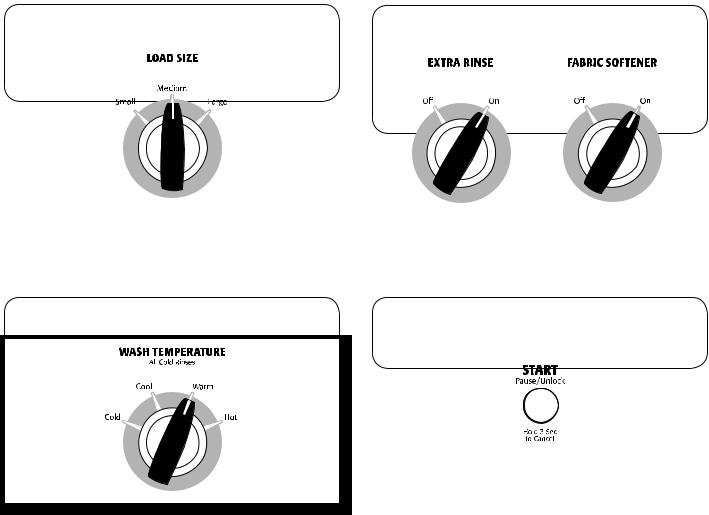
|
7. Select LOAD SIZE |
|
|
9. Select options, if desired |
|||||||||||
|
|
|
|
|
|
|
|
|
|
|
|
|
|
|
|
|
|
|
|
|
|
|
|
|
|
|
|
|
|
|
|
|
|
|
|
|
|
|
|
|
|
|
|
|
|
|
|
|
|
|
|
|
|
|
|
|
|
|
|
|
|
|
|
|
|
|
|
|
|
|
|
|
|
|
|
|
|
|
|
|
|
|
|
|
|
|
|
|
|
|
|
|
|
|
|
|
|
|
|
|
|
|
|
|
|
|
|
|
|
|
|
|
|
|
|
|
|
|
|
|
|
|
|
|
|
|
|
|
|
|
|
|
|
|
|
|
|
|
|
|
|
|
|
|
|
|
|
|
|
|
|
|
|
|
|
|
|
|
|
Select the Load Size setting most suitable for your load. Small will add a low amount of water for smaller loads and Large will add the most amount of water for large or bulky loads. Garments need to move freely.
If you want to add an Extra Rinse to the cycle, be sure to set the Extra Rinse option knob to ON. If you are using fabric softener, be sure to set the Fabric Softener option knob to ON.
8. Select WASH TEMPERATURE |
|
|
10. Press START/PAUSE/UNLOCK |
||||
|
|
|
|
|
|
to begin wash cycle |
|
|
|
|
|
|
|
|
|
|
|
|
|
|
|
|
|
|
|
|
|
|
|
|
|
|
|
|
|
|
|
|
|
|
|
|
|
|
|
|
|
|
|
|
|
|
|
|
|
|
|
|
|
|
|
|
|
Once you select a cycle, select the desired temperature by turning the Wash Temperature knob to the appropriate setting based on your load. All rinses are cold.
NOTE: Always read and follow fabric care label instructions to avoid damage to your garments.
Wash Temperature |
Suggested Fabrics |
|
|
|
|
Hot |
|
|
Some cold water is added to save |
Whites and pastels |
|
energy. This will be cooler than |
Durable garments |
|
your hot water heater setting. |
||
Heavy soils |
||
|
||
|
|
|
Warm |
|
|
Some cold water will be added, so |
Bright colors |
|
this will be cooler than what your |
Moderate to light soils |
|
previous washer provided. |
||
|
||
|
|
|
Cool |
|
|
Warm water may be added to |
Colors that bleed |
|
assist in soil removal and to help |
or fade |
|
dissolve detergents. |
Light soils |
|
|
||
|
|
|
Cold |
|
|
This is the temperature from your |
Dark colors that |
|
faucet. If your tap cold water is |
bleed or fade |
|
very cold, warm water may be |
Light soils |
|
added to assist in soil removal |
||
|
||
and help dissolve detergent. |
|
|
|
|
Press the START/PAUSE/UNLOCK button to start the wash cycle. Filling is delayed for several minutes while load balance is sensed. When the cycle has finished, the DONE indicator will light. Promptly remove garments after cycle has completed to avoid odor, reduce wrinkling, and rusting of metal hooks, zippers, and snaps.
Unlocking the lid to add garments
If you need to open the lid to add 1 or 2 missed garments:
Press START/PAUSE/UNLOCK; the lid will unlock once the washer movement has stopped. This may take several minutes if the load was spinning at high speed. Then close lid and press START/PAUSE/UNLOCK again to restart
the cycle.
If lid is left open for more than 10 minutes, the water will pump out automatically.
Delay in water fill
Filling is delayed for 2 to 3 minutes to check for load unbalance. You will hear the hum of the spin prior to filling.
This is normal operation.
8

WASHER MAINTENANCE
WATER INLET HOSES
Replace inlet hoses after 5 years of use to reduce the risk of hose failure. Periodically inspect and replace inlet hoses if bulges, kinks, cuts, wear, or leaks are found.
When replacing your inlet hoses, mark the date of replacement on the label with a permanent marker.
NON-USE AND VACATION CARE
Operate your washer only when you are home. If moving, or not using your washer for a period of time, follow these steps:
1.Unplug or disconnect power to washer.
2.Turn off water supply to washer, to avoid flooding due to water pressure surge.
CLEANING YOUR WASHER
Keep your washer as clean and fresh as your clothes. To keep washer interior odor-free, follow this recommended monthly cleaning procedure:
1.Make sure the washer is empty.
2.Using recommended AFFRESH® washer cleaner, add one tablet to washer basket
OR
If using liquid chlorine bleach, add 1 cup (250 mL) to liquid chlorine bleach dispenser.
IMPORTANT: Do not add detergent. Do not use more than recommended amount of bleach to avoid damaging product over time.
3.Close washer lid.
4.Select NORMAL HEAVY cycle, HOT Temperature, and LARGE Load Size.
5.Press START/PAUSE/UNLOCK.
NOTE: For best results, do not interrupt cycle. If cycle must be interrupted, press START/PAUSE/UNLOCK twice and run a RINSE & SPIN cycle to ensure bleach has been rinsed from washer. Press and hold the START/PAUSE/UNLOCK for
3 seconds to cancel the cycle.
Cleaning the liquid fabric softener dispenser
1.Remove dispenser by grasping top with both hands and squeezing, while pushing upward with thumbs.
2.Rinse dispenser under warm water, then replace it.
NOTE: To avoid damage to the washer or clothing, do not wash clothes with the liquid fabric softener dispenser removed.
Cleaning the bleach dispenser
Wipe the inside of the bleach dispenser with a clean, damp cloth.
To clean exterior:
1.Use a soft, damp cloth or sponge to wipe up any spills.
2.Use all-purpose surface cleaner, if needed.
IMPORTANT: To avoid damaging the washer’s finish, do not use abrasive products.
WINTER STORAGE CARE
IMPORTANT: To avoid damage, install and store washer where it will not freeze. Because some water may stay in hoses, freezing can damage washer. If storing or moving during freezing weather, winterize your washer.
To winterize washer:
1.Shut off both water faucets; disconnect and drain water inlet hoses.
2.Put 1 qt. (1 L) of R.V.-type antifreeze in basket and run washer on RINSE & SPIN cycle for about 30 seconds to mix antifreeze and remaining water.
3.Unplug washer or disconnect power.
TRANSPORTING YOUR WASHER
1.Shut off both water faucets. Disconnect and drain water inlet hoses.
2.If washer will be moved during freezing weather, follow
“Winter Storage Care” directions before moving.
3.Disconnect drain from drain system and drain any remaining water into a pan or bucket. Disconnect drain hose from back of washer.
4.Unplug power cord.
5.Place inlet hoses and drain hose inside washer basket.
6.Drape power cord over edge and into washer basket.
7.Place packing tray from original shipping materials back inside washer. If you do not have packing tray, place heavy blankets or towels into basket opening. Close lid and place tape over lid and down front of washer. Keep lid taped until washer is placed in new location.
9
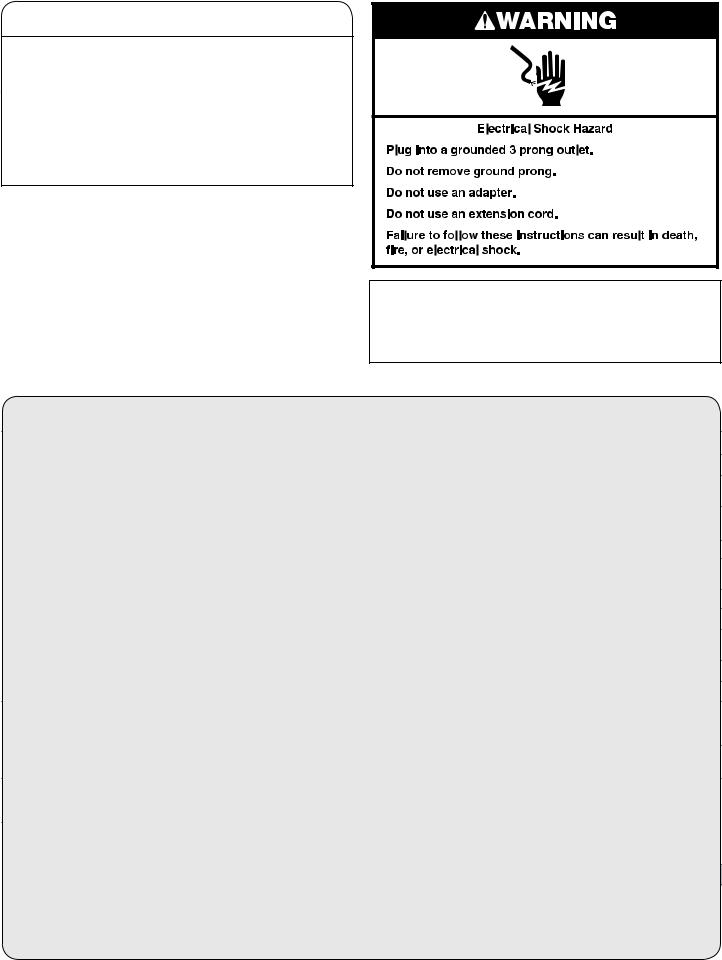
REINSTALLING/USING WASHER AGAIN
To reinstall washer after non-use, vacation, winter storage, or moving:
1.Refer to “Installation Instructions” to locate, level, and connect washer.
2.Before using again, run washer through the following recommended procedure:
To use washer again:
1.Flush water pipes and hoses. Reconnect water inlet hoses.
Turn on both water faucets.
TROUBLESHOOTING
2.Plug in washer or reconnect power.
3.Run washer through Casual cycle to clean washer and remove antifreeze, if used. Use half the manufacturer’s recommended amount of detergent for a medium-size load.
10
